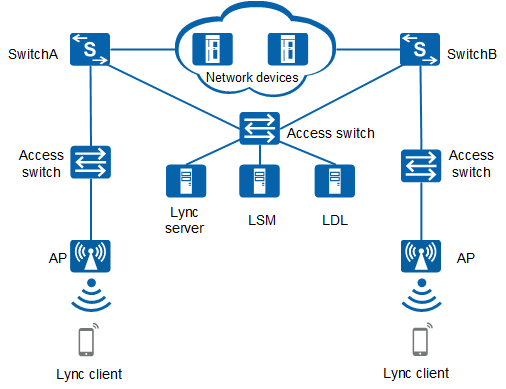Priority Increase of Lync Packets
Microsoft Lync is a set of communication software that provides voice, video, desktop sharing, and file transfer functions.
The Lync client and Lync server perform session negotiation in encryption mode, and network devices cannot identify an Lync session. That is, when Lync packets are transmitted on a network, network devices cannot determine that service flows are originated from Lync application. As a result, the priority of these service flows cannot be ensured. Microsoft provides a set of Application Programming Interfaces (APIs), which can be used by the Lync SDN Manager (LSM for short) to notify the network controller of the Lync session content through HTTP or HTTPS. The network controller can identify Lync packets, and then processes Lync packets based on priorities.
On a network, a switch can replace the network controller to interwork with the LSM and obtain information about Lync packets. The switch delivers a rule for increasing the priority of Lync packets based on the Lync session. When Lync packets are forwarded on the network, the priority is increased and QoS guarantee is achieved, thereby improving user experience.
In Figure 1, the entities and their functions are described as follows:
- Lync client: wireless terminal that has the Lync client software installed.
- Lync server: provides services including Lync voice, video, desktop sharing, and file transfer.
- Lync Dialog Listener (LDL): monitors signaling of Lync clients and sends information such as session setup and deletion to the LSM.
- LSM: collects session information about the LDL and sends information such as session setup and deletion to SwitchA and SwitchB.
- SwitchA and SwitchB: functions as the AC and replaces the network controller to monitor flow information of the LSM and deliver it to the local device.
- Access switch: provides the priority service.
When Lync clients communicate with each other, the procedure for increasing the priority of Lync packets is as follows:
- SwitchA and SwitchB establish HTTP or HTTPS sessions with the LSM.
- The LDL detects signaling sent by Lync clients. After a Lync client sends a service request to the server, the LDL detects session establishment.
- The LDL notifies the LSM that the Lync session is set up.
- The LSM notifies SwitchA and SwitchB that the Lync session is set up.
- SwitchA and SwitchB obtain Lync flow information from the LSM. The information includes the application type (voice, video, desktop sharing, or file transfer) of Lync flows and 5-tuple information (source IP address, destination IP address, source port number, destination port number, and protocol). Then SwitchA and SwitchB deliver Lync session entries based on priorities of the Lync flows.
After the procedure, the priority of the service flow is increased when service flows exchanged between Lync clients pass through SwitchA and SwitchB.
After Lync clients complete communication, the sessions between Lync clients and the Lync server will be deleted. The LDL detects the Lync SDN Manager that the Lync session is deleted and notifies the LSM, and then the LSM notifies SwitchA and SwitchB that the Lync session is deleted. The switches delete the corresponding Lync session entries.
